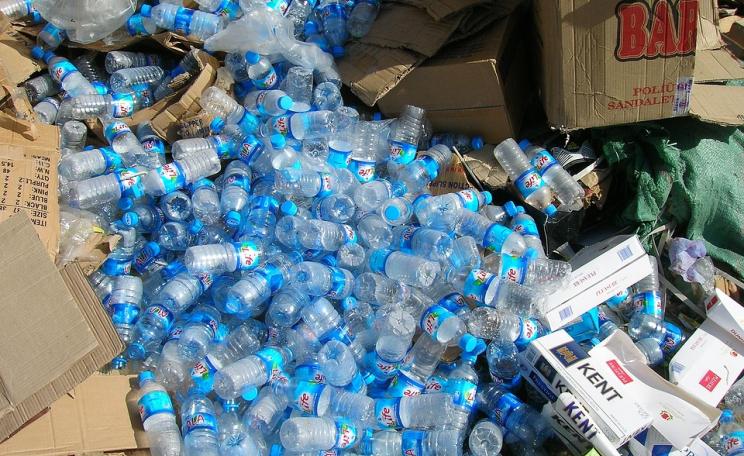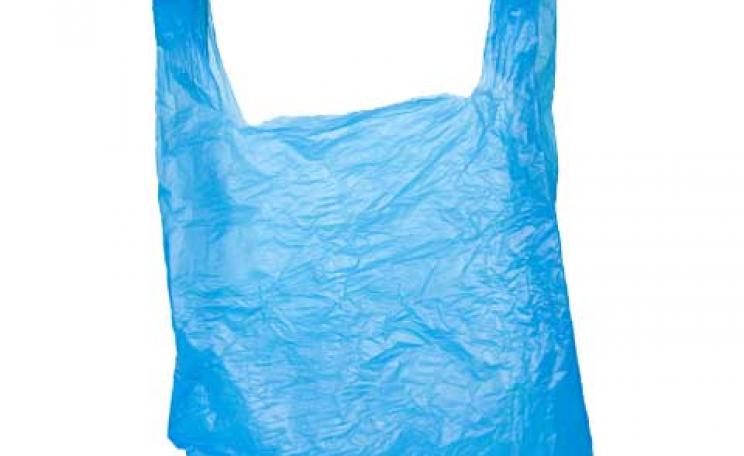Over the last couple of years, customers buying chopped tomatoes at Sainsbury’s supermarkets will have noticed a change: this staple of kitchen cupboards has swapped the good ol’ tin can for cartons. Premium chopped tomatoes went first in November 2007, and the basic range followed last month. So why did Sainsbury’s do it?
British consumers use about four billion cartons every year: they come in all shapes and sizes, can hold anything from fruit juice to beans, soups or milk and are as conspicuous as tin cans or glass jars. Many big brands use them (Innocent Drinks, Ribena, Tropicana, Covent Garden soups, etc); Tetra Pak, the leading carton manufacturer, is even a household name – although the same can’t be said of its main competitors, Norwegian company Elopak and Swiss outfit SIG Combibloc.
Many layers
Cartons are made mostly (about 75 per cent) from wood. Aseptic cartons (those that don’t need refrigeration) then use a layer of aluminium to preserve the product and layers of plastic to seal the container. Non-aseptic cartons (for fresh products with shorter shelf lives) don’t need aluminium.
Because of this multi-layer system, cartons have often been viewed as composite products difficult to recycle and not all that environmentally-friendly. Yet cartons are one of the greener forms of packaging available.
'Life Cycle Analyses (LCA) have demonstrated that cartons are a better solution, but we haven’t communicated this to consumers very well to date,' says Michael Hecker, head of group environment, health and safety at SIG Combibloc.
Speaking in his capacity as a member of the Alliance for Beverage Cartons and the Environment UK (ACE UK), a trade organisation that comprises the three main carton manufacturers and the two main paper mills, Korsnäs and Stora Enso, Mark Eaves, Elopak’s UK and Ireland general manager, says there was a certain level of complacency amongst carton manufacturers.
'We always knew we were green and we thought it’d be obvious to everyone else since cartons come from trees,' he says.
Scientific evidence
With consumers increasingly preferring scientific evidence to heart-felt assumptions, a number of LCAs have been produced over the last few years. A peer-reviewed study commissioned by Tetra Pak, which compared the Tetra Recart (the name of the tomato container) and steel cans, provided stark results: steel cans use twice as much energy during their life cycle as cartons, they produce 2.5 times more waste and more than three times the amount of CO2 emissions.
Another study comparing the environmental footprint of cartons (SIG’s Combibloc in this case), glass jars, tin cans and retortable pouches came up with similar conclusions. The comparative LCA led by the German institute IFEU, measured performance in eight categories. Cartons came ahead in all but one category (use of nature, because of their use of trees). The study showed that cartons’ total primary energy consumption was the lowest of all four systems. The difference was even starker for CO2 emissions, with pouches emitting 57 per cent more CO2 over their lifecycle than cartons, tin cans 120 per cent more and glass jars 150 per cent more.
Both studies put the differences down to raw material, weight and shape. Cartons’ main raw material is wood, a renewable source, and paper mills use wood dust and waste as their main source of energy to convert it to paperboard. Steel, glass or aluminium containers on the other hand need large amounts of fossil fuel to convert their respective raw materials. Then there’s the light weight and the rectangular shape, two attributes that make cartons highly efficient in transport compared to round – and relatively heavy – cans and jars.
The problem of recycling
The cartons’ Achilles heel remains recycling. Cartons are recyclable in theory, but the practice has somewhat lagged behind. The European average for carton recycling is 33 per cent, but it hides huge variations, from nearly 90 per cent in Belgium to around 15 per cent in the UK. The reason why it’s so good in Belgium and so poor in Britain is down to politics.
'The insistence on UK recycling targets being weight-based has been terrible for cartons,' says Eaves. 'Cartons are a very light-weight packaging and shouldn’t be treated the same way.'
They were, and the result is that until three years ago there was little carton collection or recycling to speak of. But in 2007, ACE UK started investing in bring banks to encourage collection and facilitate recycling.
'We have basically built a recycling infrastructure from scratch,' Eaves says. 'The onus is on local authorities to collect but since there are more than 400 of them, all with different methodologies, we saw the bring banks as the best short-term solution to kick-start the process.'
Almost 90 per cent of all local authorities are now equipped with bring banks. ACE UK won’t say how much it’s invested in this recycling effort, but the figure runs into millions. Contributions come from carton manufacturers and are based on market shares. As well as the bring banks, the organisation has dedicated much of its time to working with local authorities to increase kerbside collection: 21 per cent now provide the service.
Carton manufacturers have come under a lot of criticism for this poor performance, but Mario Abreu, director of forestry and recycling at Tetra Pak, stands his ground.
'We are not in the business of recycling,' he says. 'Cartons are recyclable but the rates are still not what we would like them to be because of a combination of inferior collection facilities, consumer habits and the economics of recycling.'
This last point is particularly relevant in the UK: the only mill capable of recycling cartons closed in 2006 due to economic difficulties, and there currently aren’t enough cartons for another mill to invest in recycling facilities (the UK collects about 10,000 tonnes a year, while mills in Europe deal with more than 100,000).
So until the UK steps up its collection efforts, collected cartons will continue to be baled and shipped to a mill in Sweden on empty Ikea ships.
Greener, even in the bin
It’s unfortunate, for carton recycling is straightforward and generally sought after by recyclers because of the high quality of wood fibres. The paperboard, aluminium and polymer are easily separated. Fibres are turned into paper or cardboard; the fate of the aluminium and plastic depends on the mill. In Sweden, they are used for energy recovery. In other countries (Brazil, Italy, Poland), they can be used together as polyAl, a material used for injection moulding, or separated to be recycled individually.
Interestingly, the IFEU lifecycle assessment results mentioned above are based on average European recycling rates for all materials, cartons included. But sensitivity analyses reveal that even with zero per cent carton recycling and 66 per cent glass or steel can recycling, cartons would still outperform other types of containers because of their low energy requirements in the production process.
No wonder then that Tetra Pak et al are keen to highlight their product’s renewability. The recent rush for Forest Stewardship Council (FSC) certification is a case in point. Tetra Pak announced that three-quarters of its cartons in the UK and Ireland would be FSC-certified by the end of 2010. That’s a jump from 200 million to more than one billion cartons. All three companies have committed to sourcing 100 per cent of their wood fibres from legal and acceptable sources by 2015 and securing Chain of Custody Certification for their paperboard mills by 2015, and for their beverage carton manufacturing plants by 2018. This means cartons will have to be traceable all the way back from their shelf to the forest they came from.
FSC certification and the likes may not be perfect but it commands attention in a world of sustainable business. Stuart Lendrum, printing and packaging manager at Sainsbury’s, oversaw the chopped tomato switch and says that the FSC certification definitely worked in favour of cartons.
'We make changes in our packaging to make things better – for instance by using less packaging or more recycled content – so if we’re going to use virgin material, we want to ensure it comes from a sustainable source and FSC gave us that confidence.'
Winning hearts and minds?
Lendrum says customer response has been good and comforted their decision to extend cartons to the basic chopped tomatoes range. Hecker says that German supermarket chain Lidl has been enthusiastically promoting its FSC-certified juice cartons. And Harvey Lees, buyer manager at Asda, reports similarly positive feedback on the recent switch in the packaging of their baked beans from cans to cartons.
Carton manufacturers know they have to keep on innovating and can’t afford to bask in their green glow. Tetra Pak and Elopak have signed up to the WWF Climate Savers programme and committed to reduce their CO2 emissions to 10 per cent below 2005 levels by 2010 for Tetra Pak and by 15 per cent from 2008 levels by 2011 for Elopak. SIG for its part is aiming for a 40 per cent reduction between 2010 and 2015, and a 25% reduction in waste.
Tetra Pak is also experimenting with bioplastic; SIG is trying to address aluminium traceability with its suppliers, and all are exploring ways of reducing the amount of aluminium and plastic used in cartons since these materials account for 80 per cent of cartons’ CO2 emissions.
Lees at Asda says the retailer doesn’t exclude rolling out cartons to other products if the switch, which took place in June 2009, works out well. Other retailers and food manufacturers will no doubt be watching too: WRAP, the UK Government’s Waste and Recycling Action Programme, plans to publish a LCA on milk packaging in spring 2010, the results of which should make interesting reading. A 2007 study by environmental consultancy LEK showed that cartons produced 30 per cent to 40 per cent less CO2 emissions than HDPE milk bottles. But Eaves says that historical investments, such as plastic packaging in the dairy industry, are hard to overturn, as are consumers’ perceptions of what is ‘normal’, although he is hopeful that with increasing environmental awareness, packaging decisions will be reviewed in the medium-term.
In the mean time, carton manufacturers know they have an uphill struggle to improve carton recycling in the UK. As ACE UK put it, 'our plan is to continue working at local level and keep on ringing a bell every time a local authority converts to kerbside recycling'.
Emilie Filou is a freelance journalist
| READ MORE... | |
 |
HOW TO MAKE A DIFFERENCE CASE STUDY: recycling waste wood Mel Poluck visits a flagship environmental project that rescues, reuses and recycles tonnes of wood destined for landfills, doing much the same for those it employs |
 |
COMMENT The more we recycle, the more waste firms profit Earlier this month, campaigner Shlomo Dowen won a landmark High Court case that forced Nottinghamshire council to reveal its financial arrangements with waste contractor Veolia Environmental Services. So what did Veolia want to keep so quiet? |
 |
GREEN LIVING Behind the label: Recycled Toilet Tissue Your recycled loo paper may be soft, strong and very, very long, but is it really all that green? Pat Thomas gets to the bottom of an issue of convenience |
 |
INVESTIGATION Can we trust the FSC? It's the logo we all look for when buying furniture and wood products. But the Forest Stewardship Council has come in for some serious criticism. Matilda Lee looks at both sides of the argument |
 |
INVESTIGATION How can we tell which companies are really green? Green claims are everywhere: surely there must be some simple way of measuring exactly what impact a company is having on the climate? |





